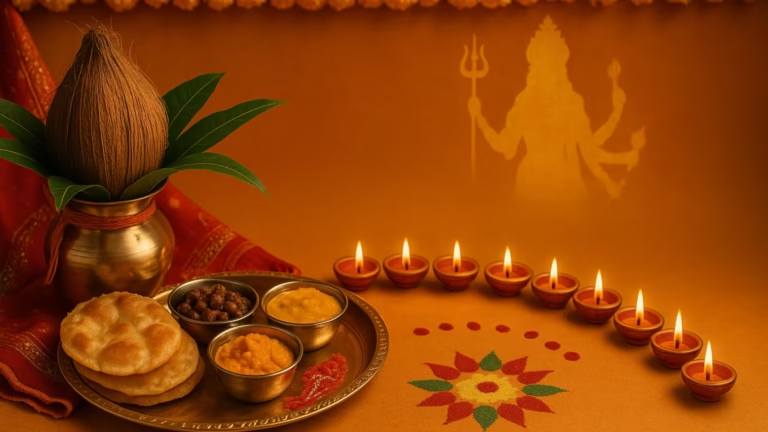Kumbhabhishekam is one of the most sacred and elaborate rituals in Hindu tradition, especially in South India. It marks the consecration or re-consecration of a Hindu temple, a process that revitalizes the spiritual energy of the deity and sanctifies the temple structure. The term “Kumbhabhishekam” is derived from two Sanskrit words: Kumbha meaning “sacred pot” and Abhishekam meaning “ritual bathing or anointment.” This grand ceremony is a rare and spiritually charged event that draws thousands of devotees and is deeply rooted in Vedic practices.
Table of Contents
What is Kumbhabhishekam?
Kumbhabhishekam refers to the ritual of infusing divine energy into a temple and its deity. It is usually performed:
- At the time of a new temple’s inauguration.
- During the renovation or restoration of an existing temple.
- At regular intervals (typically every 12 years) to re-energize the sanctum and deities.
The ritual involves elaborate Vedic chants, homas (fire sacrifices), abhishekas (ritual bathing), and ceremonial processions. The main highlight is the pouring of sacred water from the kalashas (metal pots) placed atop the temple towers (gopurams) and sanctum, symbolizing the transfer of cosmic energy.
Read Also: 108 Names of Lord Shiva: Meaning, Significance, and Use in Spiritual Practice
Origins and Scriptural References
The tradition of Kumbhabhishekam is deeply rooted in the Agama Shastras and Vedas, especially the Vaikhanasa and Pancharatra Agamas for Vaishnavite temples, and Saiva Agamas for Shaivite temples. According to these scriptures, the process of constructing and consecrating a temple is not just an architectural endeavor but a spiritual one, where rituals are used to invite the divine presence into the deity idol (vigraha).
Key Rituals and Ceremonies
Kumbhabhishekam is not a single ritual but a series of ceremonies conducted over several days, often 3, 5, or 9 days, depending on the temple’s tradition.
- Yaga Shala Construction:
A temporary sacrificial altar is built on the temple premises. This is where priests perform Vedic homas to invoke various deities and purify the atmosphere.
- Kalasha Sthapana:
Sacred pots (kalashas) filled with sanctified water, herbs, and energized with mantras are placed on top of the temple’s vimana (tower) and sanctum.
- Homas and Chanting:
Vedic rituals including Ganapati Homa, Navagraha Homa, and other specific homas are performed. Priests chant mantras from the Vedas and Agamas to invoke divine presence.
- Punah Pratishtha (Re-consecration):
The deity inside the sanctum is ceremonially re-energized using mantras and abhishekam. The idol is treated like a living being, with ritual bathing, dressing, and ornamentation.
- Kumbhabhishekam (Main Event):
On the final day, the water from the kalashas is ceremonially poured over the temple tower and deity while Vedic hymns are chanted. This marks the climax of the consecration.
Spiritual Significance
Kumbhabhishekam is not just a ritual; it holds deep spiritual meaning:
- Recharging Divine Energy: Temples are believed to be centers of cosmic energy. Over time, this energy diminishes. Kumbhabhishekam helps to revitalize this energy field.
- Connecting Devotees to the Divine: The ceremony creates a powerful spiritual environment that helps devotees deepen their connection with the deity.
- Collective Upliftment: The rituals benefit not just the temple, but the community. Participating in or witnessing Kumbhabhishekam is considered highly meritorious.
Scientific and Architectural Relevance
Interestingly, Kumbhabhishekam also reflects an advanced understanding of architecture and energy flow. Temples are built according to Vastu Shastra, and the pouring of water on the temple’s gopuram is symbolic of energy being circulated through the temple’s structural grid.
When is Kumbhabhishekam Performed?
Astrologically auspicious timings are chosen using Panchang (Hindu calendar). The muhurta (auspicious moment) for the main event is determined by expert astrologers and temple priests.
Devotee Participation and Customs
During Kumbhabhishekam:
- Devotees fast, chant mantras, and participate in homas.
- Women draw kolams (sacred rangoli) and light lamps.
- Many offer donations, seva, and distribute prasadam.
Conclusion
Kumbhabhishekam is a vibrant confluence of devotion, Vedic wisdom, architecture, and cosmic energy. It symbolizes the sacred union between the divine and the earthly, invoking blessings for the temple and its devotees. Whether one witnesses it once or participates actively, it leaves a lasting spiritual imprint on the mind and soul.
References:
- Agama Shastras and Vastu Texts
- “Hindu Temple Rituals and Their Meanings” – R. Ganapathi Iyer
- Sringeri Sharada Peetham Archives
- Official websites of renowned temples like Madurai Meenakshi, Chidambaram Nataraja, and Kanchipuram Ekambareswarar Temple
Whatsapp Channel Link :–https://whatsapp.com/channel/0029VbB0KvuIHphFXKcwyq3B
Read Also: Indian Air Force Medical Assistant Recruitment 2025 – Complete Details for Intake 02/2026



